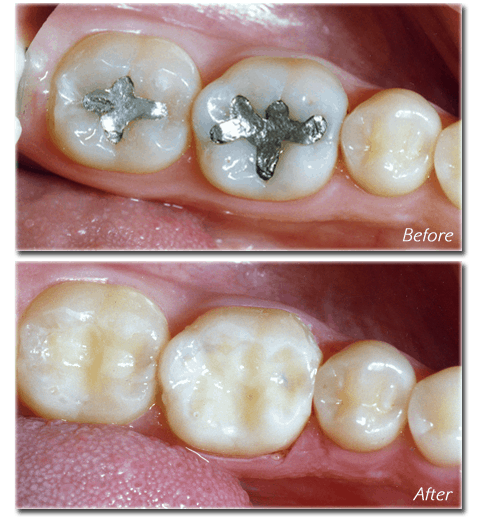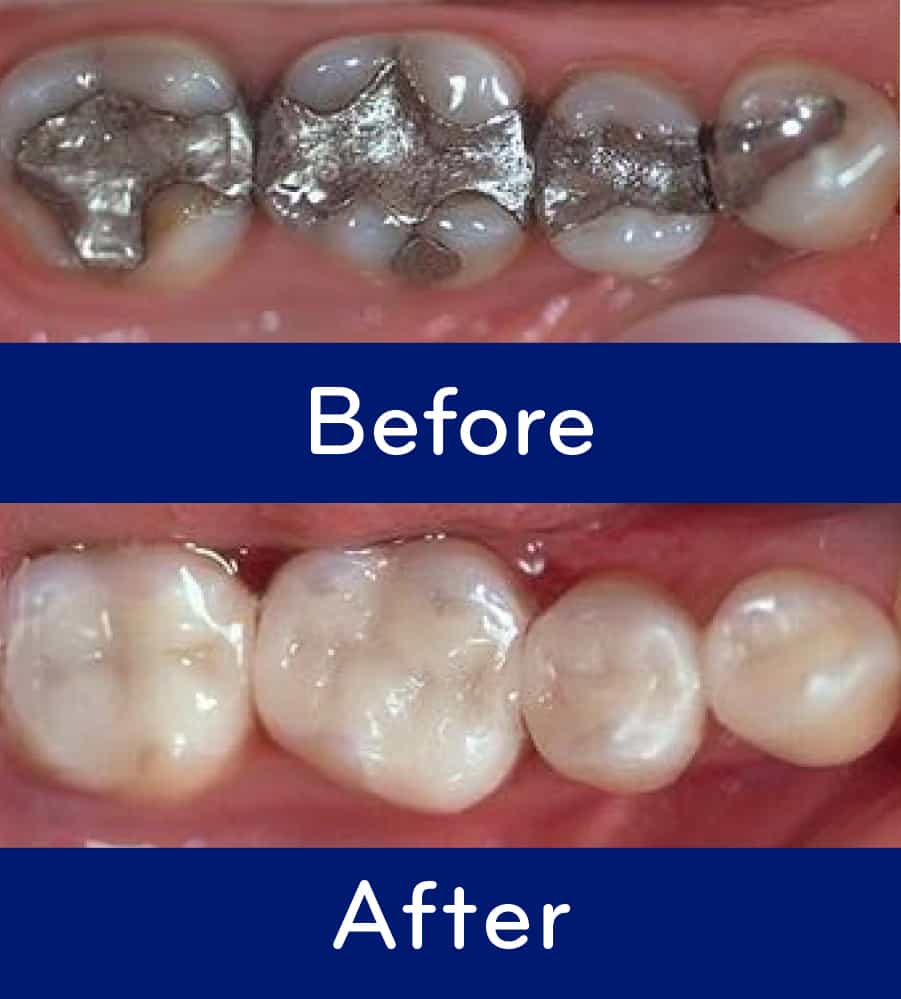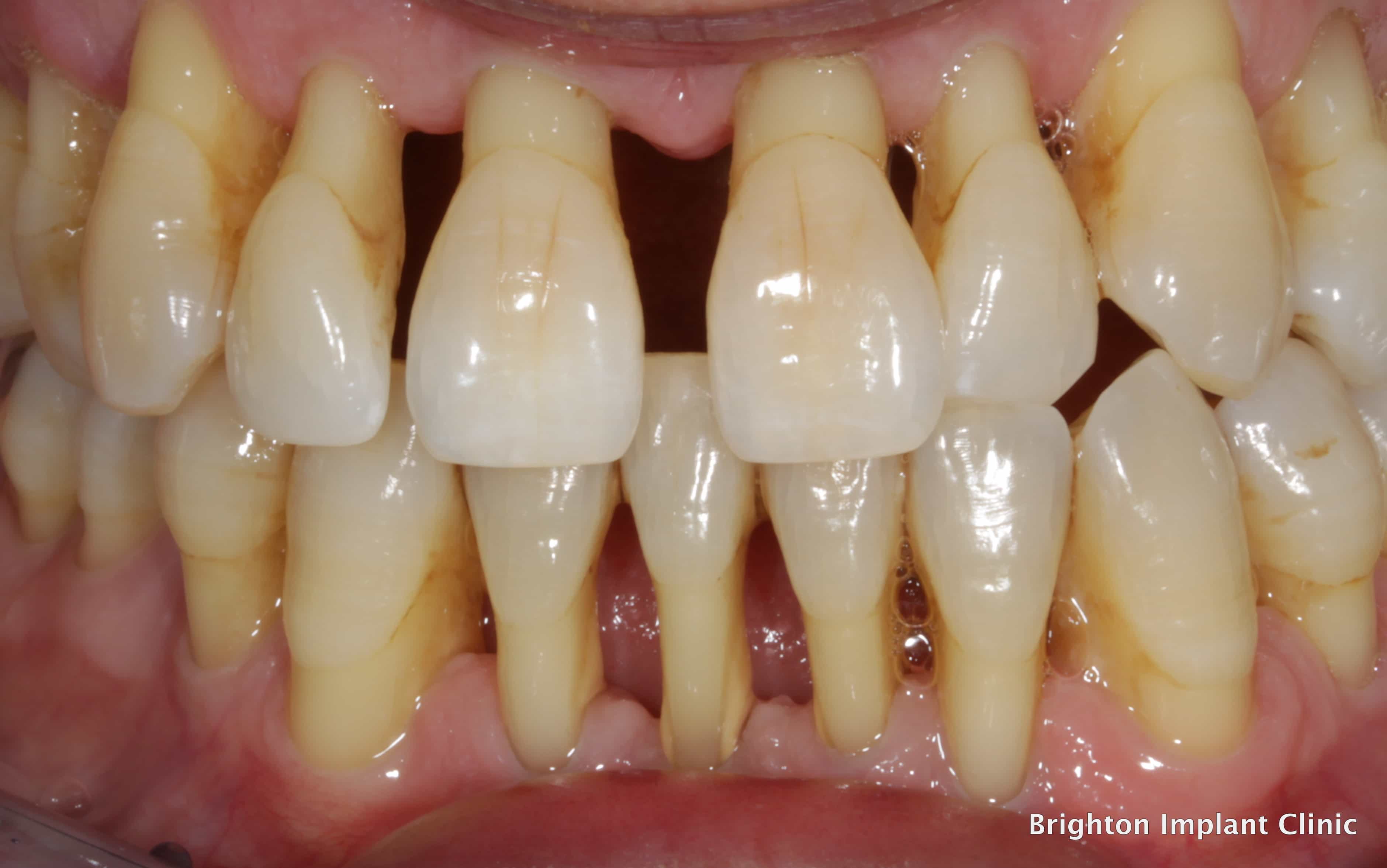
Amalgam vs. Tooth Colored Fillings
If you’ve ever received amalgam fillings, you know what they are – metal placed in the tooth to fill a cavity. When you open your mouth, you see the metal. It’s a tell-tale sign you had a cavity. The shiny silver tooth filling.
Most people don’t want to open their mouth and see silver fillings showing in there. It’s not attractive. But, in addition to being unsightly, the metal fillings contain mercury and need to be removed in a safe manner.
This isn’t the only reason many people are moving away from amalgam fillings. Holistic dentistry has recommended removal of amalgam fillings for over 30 years. There are many others, and understanding why will help you decide if you should not only seek tooth colored cavities and have the amalgam fillings replaced.

silver fillings safe
What are Composite and Amalgam Fillings?
Amalgam fillings are the metal fillings that most people are used to because they have been used for many years. Amalgam fillings contain 50% and it has gotten a bad rap lately with accusations of being toxic. Tooth-colored fillings are also known as composite resin fillings. Composite fillings are tooth colored and have been called porcelain fillings.
What are Inlays and Onlays?
Composite fillings are not to be confused with inlays and onlays which are laboratory made pieces of porcelain or metal custom made to fit the damaged portion of the tooth. Inlays and onlays can be used when the cavity is very large. Inlays and onlays are cemented or bonded into the cavity. Inlays and onlays are much more expensive than fillings because the lab needs to be paid for fabrication.
Amalgam fillings hold up better to teeth clenching, but more mercury is released during clenching.
Composite Fillings look Better than Silver Fillings
While this has already been noted, it’s worth mentioning again. Amalgam filings are highly noticeable in the mouth. Tooth-colored fillings are not because they are white. Only if someone really looks at the teeth will they notice there is a filling.

amalgam filling removal1
Amalgam Material corrodes and causes Sensitivities
Some people are allergic to metal and when they receive amalgam fillings they end up with a bothersome reaction. Amalgam fillings are not recommended by biological dentistry. Unfortunately, many people don’t know it’s their metal fillings that is causing them so much grief and it can be years before a dentist points out that their physical issues may be because of their fillings. Amalgam fillings contain mercury, silver, copper and tin. These metals break down over time as they corrode.
Metal allergies are usually not a concern when people choose tooth colored fillings. They are made of composite resins. Some composite resin fillings contain BPAs, but most current materials are BPA free. New tooth colored filling materials are made of a ceramic resin material. These resins have fewer chemicals and cause fewer reactions.
Mercury Fillings Should be Removed Safely
Amalgam fillings contain mercury in them. This mercury can be toxic in large amounts. Are amalgam fillings safe to have in you mouth? While the filling itself may not cause an issue, it can contribute to the total amount of mercury in the body if someone is exposed to it in other ways. When mercury fillings are removed is should be done safely using the IAOMT protocol for amalgam filling removal.
Tooth Preservation – Amalgam requires a bigger hole
When using ceramic fillings, less of the tooth needs to be removed when compared to how much needs to be removed with metal fillings. This means that the tooth natural structure remains more intact.
Tooth Strength is reinforced with composites
Ceramic fillings preserve the strength of the tooth much more than amalgam fillings because they chemically bond to the tooth. This can mean fewer recurrent oral issues and cavities in the future.
Tooth Decay or Caries
Decaying is a concern for teeth that have amalgam fillings. Amalgam fillings are known to cause crackes or fissures where bacteria can infiltrate. This bacteria can lead to infection and decay quickly if the cracks and fissures are not caught in time.
Porcelain fillings are less likely to crack teeth because they bond to the tooth. Amalgam expands over time and puts pressure on the tooth.

what causes periodontal disease
Stain and Abrasion
Composite fillings are much more resistant to stains. This is highly important to individuals who are concerned about the whiteness of their teeth.
Corrosion
Since amalgam fillings are metal, they are at risk for corrosion. This happens over time, and is one of the reasons people have to get their fillings redone.
Porcelain, tooth-colored fillings, don’t have that risk. They are ceramic, so they don’t corrode.
Chewing Comfort and Sensitivity
Many people report that after receiving amalgam fillings, they have some issues with chewing. They may have to go back to the dentist to have the filling corrected to return to normal chewing. This isn’t as common for porcelain fillings as it adheres to the tooth in a different way.
Are Amalgams Stronger than Composites?
Both amalgam and composite fillings are durable. They are meant to last a lifetime. This is true for the ceramic tooth-colored ones also. Most people don’t think they would be as strong, but they are extremely resistant to breakage, chips, and cracks.
Amalgam Fillings Cost less than Composites
Amalgam material costs less than composite fillings. Since metal is less expensive to produce, most dentists offer it. Patients often choose metal fillings because they are cheaper.
Does Insurance Pay for Amalgam Filling Replacement?
Many insurance companies do not cover ceramic fillings. They believe amalgams are just as good and less expensive, so they prefer to cover those instead. This means people who want the tooth colored fillings will need to pay out of pocket.
Availability
Most dentists offer tooth-colored fillings now because so many patients request them for the aesthetic benefits. However, some continue to stand strong behind amalgam filings claiming the material for them is superior. Just be sure to check with the dentist you choose to see if ceramic fillings are an option.
Should You Replace Amalgam with Composite Fillings?
For those who are getting a filling, all you have to do is ask for a porcelain filling, ceramic filling, or tooth-colored filling. The dentist will know what you mean and will probably ask if you know you’ll have to pay whatever is left over after the insurance company reviews the service.
If you already have amalgam fillings, you can have them replaced. Not all dentists replace amalgam fillings. It is a process that requires safety measures to be addressed. Since removing the amalgam fillings can lead to mercury dust and gas floating in the area, it’s important the dentist have experience performing this type of procedure. This includes being able to remove the metal fillings with minimal debris, wears specialty gloves, and ensure there’s enough ventilation and air filtration. A special safe mercury removal protocol is specified by the IAOMT.org that we follow.
Once the amalgam fillings are removed, the dentist can put in tooth-colored ones. It’s done in just the same way as they would be put in if you decided to get a tooth-colored one in the first place.
Contact Us for Tooth-Colored Fillings
We offer tooth-colored fillings and we can replace amalgam fillings. We abide by IAOMT safety standards when it comes to removing amalgam fillings, so you can be rest assured we limit the exposure of mercury as much as possible.
As strong supporters of ceramic fillings and dental implants, we strive to educate dental patients on the benefits of tooth-colored fillings. If you have any questions about metal and metal-free fillings or implants, please contact us. We would be happy to answer all of them.

 (301) 421 1996
(301) 421 1996 burtonsvillesmiles@gmail.com
burtonsvillesmiles@gmail.com